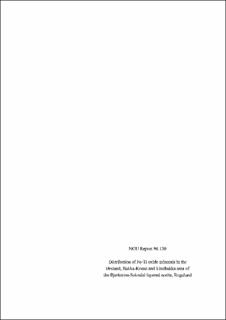| dc.contributor.author | Larsen, Rune B. | |
| dc.coverage.spatial | 13114 Sokndal | |
| dc.date.accessioned | 2020-07-15T08:26:43Z | |
| dc.date.available | 2020-07-15T08:26:43Z | |
| dc.date.issued | 1996 | |
| dc.identifier.issn | 0800-3416 | |
| dc.identifier.uri | https://hdl.handle.net/11250/2666003 | |
| dc.description.abstract | Geological mapping in scale 1:5000 in the Sokndal Lobe of the Bjerkreim-Sokndal layered norite intrusion has confirmed that cyclic unit no.IV of the magmatic stratigraphy comprise a high density of Fe-Ti oxide rich layers. The area naturally divides in the Ørsland, Bakka-Krune and Einebakka areas which indi- vidually are shaped as mega-lenses connested to each other via more narrow zones. However, seen together they comprise an open synfom dipping 40o to the west. Zones with a high desity of Fe-Ti oxide rich layers has a patchy distri- bution exhibiting thicknesses from 1 to 120 meters and a limited extent along strike. The Bakka-Krune area has the largest size but the most patchy appearance of Fe-Ti oxides which makes it very difficult to evaluate the total resources. The Einebakka area comprise the largest continuous zone of Fe-Ti oxide rich layers with a documented strike length of 450 meters and thicknesses between 20 and 120 meters. | |
| dc.language.iso | eng | |
| dc.relation.ispartofseries | NGU-Rapport (96.130) | |
| dc.rights | Navngivelse 4.0 Internasjonal | |
| dc.rights.uri | http://creativecommons.org/licenses/by/4.0/deed.no | |
| dc.subject | DYPBERGART | |
| dc.subject | ILMENITT | |
| dc.subject | TITAN | |
| dc.subject | BERGGRUNN | |
| dc.title | Distribution of Fe-Ti oxide minerals in the Ørsland, Bakka-Krune and Einebakka area of the Bjerkreim-Sokndal layered norite, Rogaland | |
| dc.type | Report | |
| dc.description.localcode | 44433 | |
| dc.source.pagenumber | 9 | |

